Pharmaceutical Industry Today
Global Plasma Apheresis Machines Market to Reach USD 0.58 Billion by 2031, Driven by Demand for Plasma-Derived Therapies and Technological Advancements
August 2025 | Pune, India — According to the latest publication by QYResearch, titled “Global Plasma Apheresis Machines Market Report 2025–2031”, the global market for plasma apheresis machines is projected to reach USD 0.58 billion by 2031, expanding at a steady CAGR of 3.6% during the forecast period (2025–2031). The report highlights significant trends, market dynamics, and opportunities shaping the future of the apheresis technology landscape.
Growing Need for Plasma-Derived Therapies Fuels Market Expansion
The rising demand for plasma-derived medicinal products (PDMPs)—such as immunoglobulins, clotting factors, and albumin—used in the treatment of immune disorders, neurological conditions, and bleeding disorders, is a key growth driver. The increasing incidence of autoimmune diseases such as myasthenia gravis, Guillain-Barré syndrome, and multiple sclerosis further fuels the demand for therapeutic plasmapheresis procedures worldwide.
Download Exclusive Research Report PDF Sample: (Including Full TOC, List of Tables & Figures, Chart) @ https://www.qyresearch.in/request-sample/medical-devices-consumables-plasma-apheresis-machines-global-market-share-and-ranking-overall-sales-and-demand-forecast-2025-2031
Market Drivers
Rising Demand for Plasma-Derived Therapies
Plasma-Derived Medicinal Products (PDMPs) such as immunoglobulins, clotting factors, and albumin are critical for treating a variety of diseases, including immune disorders, hemophilia, and certain neurological conditions. As the demand for PDMPs increases globally, the need for plasmapheresis machines (used for plasma collection) is also growing. This is a significant driver for the market.
Increasing Prevalence of Autoimmune Diseases: Diseases such as myasthenia gravis, multiple sclerosis, and Guillain-Barré syndrome, which require therapeutic plasmapheresis, are becoming more common, driving the demand for plasmapheresis treatments.
Technological Advancements in Plasmapheresis Machines
Automation and Efficiency: Modern plasmapheresis machines are more automated, reducing the need for manual intervention and improving the efficiency of plasma collection. Innovations such as real-time monitoring, data analytics, and integrated software are enhancing the performance of plasmapheresis machines and providing better control and safety during the process.
Miniaturization and Portability: Compact, portable plasmapheresis machines are being developed, allowing for easier use in outpatient settings, mobile clinics, and even at home for chronic patients. This accessibility is driving adoption in more diverse healthcare settings, expanding the market.
Growth in Blood Donation and Collection Centers
Increased Plasma Donation: With the growing need for plasma donations for therapeutic use, blood banks and plasma collection centers are expanding. These facilities require advanced plasmapheresis machines to efficiently separate plasma from whole blood for further processing into medicinal products.
Improved Plasma Collection Methods: The adoption of apheresis techniques, including plasmapheresis, is increasing in blood centers as it allows for the targeted collection of plasma while returning other blood components to the donor. This is driving demand for more efficient plasmapheresis systems.
Expanding Therapeutic Applications of Plasmapheresis
Neurological and Autoimmune Disorders: Plasmapheresis is increasingly being used to treat neurological conditions such as multiple sclerosis, Guillain-Barré syndrome, and myasthenia gravis, as well as other autoimmune diseases. As these conditions become more prevalent globally, the demand for plasmapheresis systems rises.
Acute and Chronic Conditions: The use of plasmapheresis in treating acute liver failure, toxic overdose, and severe infections is expanding, providing further growth opportunities for plasmapheresis machine manufacturers.
Cancer Treatment: Some forms of plasmapheresis are being used to manage side effects of chemotherapy and other cancer treatments, such as removing certain toxins from the blood.
Market Challenges
High Manufacturing and R&D Costs
Expensive Development: The design and manufacturing of plasmapheresis machines require significant investment in research and development (R&D), particularly for improving the efficiency and safety of the machines. These costs include developing advanced filtration systems, automated features, and sophisticated monitoring systems. As a result, the high cost of developing new models can slow down innovation and increase the overall price of plasmapheresis machines.
High Production Costs: The specialized materials, precision engineering, and medical-grade components required to produce plasmapheresis machines contribute to high production costs. These factors limit the ability to produce cost-effective machines, making it difficult to reduce the final price and improve affordability.
Complexity and Maintenance of Equipment
Technical Complexity: Plasmapheresis machines are highly complex devices that require a deep understanding of both the mechanical and biological systems involved. The complexity of the machines can be a barrier to efficient operation, limiting their accessibility in hospitals or clinics with less specialized staff. The difficulty in operating and maintaining these devices can also discourage healthcare facilities from adopting them.
Maintenance and Downtime: Plasmapheresis machines require regular maintenance to ensure their accuracy and efficiency. The costs associated with maintenance and replacement of parts (such as filters, tubing, and sensors) can be significant. In addition, downtime during maintenance can disrupt the operations of healthcare centers that rely on plasmapheresis machines, which can lead to delays in patient treatments.
Limited Skilled Personnel
Shortage of Trained Operators: Operating plasmapheresis machines requires specialized knowledge and skills. Hospitals and clinics may struggle to find or retain enough trained professionals to operate these machines effectively. This limits the widespread adoption of plasmapheresis devices, especially in low-resource regions or rural areas.
Training Requirements: To ensure the safe and effective use of plasmapheresis machines, healthcare professionals must undergo extensive training. This includes understanding the machine's software and hardware systems, as well as knowing how to monitor patient vitals and plasma quality during treatment. The need for ongoing training adds to operational costs and limits the scalability of plasmapheresis machine usage.
Lack of Standardization
Variation in Machine Models: There is a lack of standardization in the design and functionality of plasmapheresis machines, which results in variations in features, user interfaces, and treatment protocols across different manufacturers. This can lead to confusion and difficulties for healthcare providers who may need to use machines from different manufacturers. Standardization of protocols and equipment could streamline training and improve the overall effectiveness of plasmapheresis treatments.
Competition from Alternative Therapies
Emerging Therapies: There are other treatment options available for conditions treated by plasmapheresis, including pharmacological therapies, biologic agents, and immunosuppressive drugs. As these alternative treatments continue to evolve and improve, plasmapheresis may face growing competition, especially if these options offer comparable or better outcomes with fewer side effects.
Cost-Effectiveness of Alternatives: Some healthcare providers may find that alternative treatments are more cost-effective or easier to administer than plasmapheresis, which could deter the adoption of plasmapheresis machines. Additionally, if alternative therapies are more widely accepted or covered by insurance, plasmapheresis may face challenges in competing for treatment space.
Market Segmentation Insights
By Product Type: The centrifugal separation segment leads the market, accounting for 79.1% of global revenue share in 2024, owing to its high efficiency in plasma extraction and wide acceptance across clinical settings.
By Application: Blood centers remain the largest end-user segment, with a market share of 59.2%, due to the increasing number of plasma donation drives and expanded therapeutic use of collected plasma.
Key Market Players
The market is moderately consolidated, with the top five players controlling approximately 75.0% of the global revenue in 2024. Leading manufacturers include:
- Terumo BCT
- Fresenius Kabi
- Haemonetics
- Baxter
- B. Braun
Other notable players include Nikkiso, Miltenyi Biotec, Asahi Kasei Medical, Kaneka Medix, and Nigale.
Expanding Clinical Applications Unlock New Opportunities
Beyond traditional uses, plasmapheresis is gaining traction in the management of acute liver failure, severe infections, and side effects of chemotherapy. This expansion into oncology support care and critical care applications is opening new avenues for growth and adoption in hospitals and specialty clinics.
Buy Full Market Report Now, Report delivery time within 24 hours @ (Pages: 124|Tables: 117): https://www.qyresearch.in/pre-order-inquiry/medical-devices-consumables-plasma-apheresis-machines-global-market-share-and-ranking-overall-sales-and-demand-forecast-2025-2031
About QYResearch
Founded in California in 2007, QYResearch is a global leader in market intelligence and consulting. With over 17 years of experience, QYResearch has built a strong reputation for delivering accurate, actionable insights through syndicated and customized research. Our team spans major global cities and serves over 60,000 clients across five continents, supporting strategic decisions in diverse industries. Whether it’s IPO consulting, industry chain analysis, or business strategy development, QYResearch is your trusted partner in navigating complex markets.
Contact US
QY Research, INC.
India Office -
315Work Avenue, Raheja Woods, Kalyani Nagar,
Pune, Maharashtra 411006, India
Web – https://www.qyresearch.in
Tel: +91-8149736330
Email- ankit@qyresearch.com
Other Related Report From QY Research:
Global Plasma Asher Equipment Market Insights: https://www.qyresearch.in/report-details/4801356/Plasma-Asher-Equipment---Global-Market
Global Plasma Resist Strip System Market Insights: https://www.qyresearch.in/report-details/1978654/Plasma-Resist-Strip-System---Global-Market
Global Plasma Cutting Systems Market Insights: https://www.qyresearch.in/report-details/7542031/Global-Plasma-Cutting-Systems-Market-Insights
Global Handheld Plasma Cutters Market Insights: https://www.qyresearch.in/report-details/9740825/Global-Handheld-Plasma-Cutters-Market-Insights
Global Mycoplasma Removal Reagents Market Insights: https://www.qyresearch.in/report-details/0172653/Mycoplasma-Removal-Reagents---Global-Market
Global Plasma Fractionation Market Insights: https://www.qyresearch.in/report-details/0491857/Global-Plasma-Fractionation-Market-Insights
Global Plasma Display Panel Market Insights: https://www.qyresearch.in/report-details/3091826/Global-Plasma-Display-Panel-Market-Insights
Global Plasma Welding Machines Market Insights: https://www.qyresearch.in/report-details/5308164/Global-Plasma-Welding-Machines-Market-Insights
Global Plasma Etch System Market Insights: https://www.qyresearch.in/report-details/2931864/Global-Plasma-Etch-System-Market-Insights
Share on Social Media



Other Industry News
Ready to start publishing
Sign Up today!








